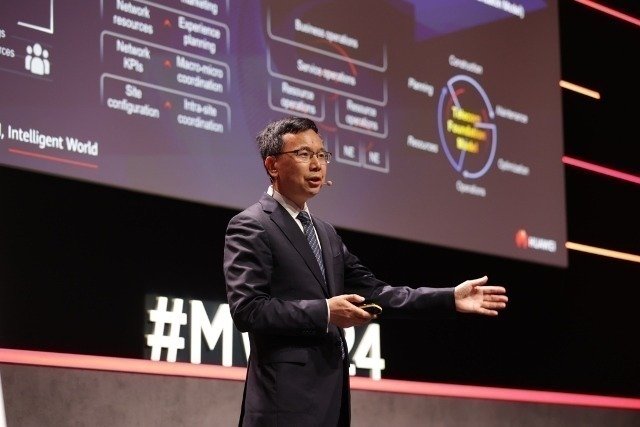In a ground-breaking initiative towards addressing the challenges of the 5.5G era, Huawei has unveiled its Telecom Foundation Model built on Artificial Intelligence (AI) and Large Language Model (LLM), designed to accelerate intelligent transformation.

Launching Huawei’s Telecom Foundation Model at the Mobile World Congress 2024 at Barcelona, Yang Chaobin, Board Member and President of ICT Products and Solutions at Huawei, said the new model is an efficient way to ensure customer experience, enhance network capabilities and optimize end-to-end (E2E) Operations and Maintenance (O&M) efficiency.
From 2G to the current 5G and the emerging 5.5G, each generation of mobile technology has brought improvements in network efficiency and user experience. However, with these advancements come higher demands on technology and the need for continuously enhanced technologies. In the 4G era, technologies like SON and SmartCare facilitated coordination across different wireless sites, while the 5G era introduced the concept of the Autonomous Driving Network, focusing on energy consumption reduction and improved network speeds and coverage.
As the 5.5G era unfolds, richer and more diversified service scenarios emerge, posing greater challenges to network capacity, Yang said. “Richer service scenarios require more differentiated and multidimensional experiences; however, they are converged on one platform. These complex architectures call for higher requirements not only on network capacity but also to network latency, availability, reliability and security as well.”
For example, in Connected People segment, comprehensive 3D and immersive services have become the new norm, requiring a substantial >100Mbit/s bandwidth and 20ms real-time experience assurance. This places immense pressure on network capabilities to deliver seamless and high-quality user experiences.
In Connected Vehicles segment, vehicles engaged in automated high-speed driving demand extensive coverage and submeter-level precise positioning. The critical nature of these requirements adds complexity to the network infrastructure to ensure the safety and efficiency of connected vehicles.
In Connected Things, the proliferation of Internet of Things (IoT) solutions, including Narrowband IoT (NB-IoT), RedCap, and Passive-IoT, necessitates multi-protocol collaboration in all scenarios. This diversity in protocols poses a challenge for networks to effectively integrate and manage various IoT solutions seamlessly.
The Connected Industry segment, on the other hand, demands flexible factories to have deterministic network with ultra-low latency and ultra-high bandwidth. The network must provide a reliable and responsive foundation for the functioning of flexible manufacturing processes, adding another layer of complexity. These requirements collectively present formidable challenges to network capabilities in the 5.5G era, Yang added. To address these challenges, 5.5G networks are designed to offer 10-fold enhancements in uplink/downlink bandwidth, latency, and reliability compared to their 5G counterparts.
Moreover, 5.5G networks come infused with additional capabilities such as Passive-IoT and native intelligence. These enhancements are strategically integrated to effectively tackle the complex business challenges posed by the diverse and convergent service scenarios in the 5.5G era. The evolution from 5G to 5.5G represents a crucial step in ensuring that telecom networks can meet the demands of an increasingly interconnected and technologically advanced world, Yang Chaobin said.
Huawei’s Telecom Foundation Model is an intelligent technology designed to help carriers achieve the best service innovation and optimal resource scheduling while driving O&M efficiency in the 5.5G era.
- For services innovation, the Telecom Foundation Model supports accurate resource evaluation and service provisioning to enable optimal resource configuration.
- For experience assurance, it supports fast multi-objective optimization to ensure deterministic user experience and optimal network performance through quick multi-objective optimization.
- For O&M efficiency improvement, it can understand and break down complex processes to achieve efficient O&M close-loop.
The model also provides role-based Copilots and scenario-based Agents, catering to the specific needs of field maintenance engineers (FMEs) and call center engineer. The intelligent agent applications can analyze and break down complex processes and orchestrate operation solutions to ensure user experience and satisfaction. Additionally, with Copilot’s intent understanding, the foundation model can provide professional information, which can improve the operation efficiency of each role. Below are some of the specific scenarios:
Agile Service Provisioning: In the Fixed Wireless Access (FWA) domain, for example, the model identifies high-value customers with over 90 percent accuracy, resulting in a 10 percent increase in service provisioning in a single sector.
Multi-Objective Optimization: In wireless experience assurance scenarios, Huawei integrates multiple features to form a unified performance prediction model, achieving a prediction accuracy of over 90 percent.
Efficient Troubleshooting: In the mobile bearer network, the model reduces the average troubleshooting time from 2.5 hours to 20 minutes by quickly identifying the root cause of issues. For FMEs, the Telecom Foundation Model can provide accurate network status, root causes of faults, and handling suggestions to help FMEs reduce the troubleshooting time by 30%.
Yang concluded by underlining the promising yet challenging nature of the Telecom Foundation Model’s application, calling for collaboration within the telecom industry. Huawei invites partners to join hands in strengthening industry cooperation, accelerating talent cultivation, and exploring value scenarios to stride towards the Intelligent Era.
